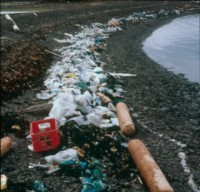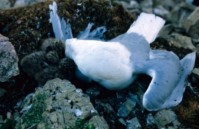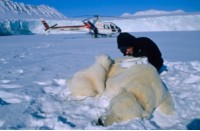|
|
Rubbish and pollutants – a new challenge
Why?
Human technology has reached Arctic Ltd, and it is not particularly favourable for the natural environment. Instead of useful things, we are sending a great deal northwards which we do not want – rubbish, heavy metals and other pollutants.
Many ocean currents and airstreams move from the south towards the Arctic. Unfortunately, they do not just take with them heat, clean air and clean water, but also rubbish and pollutants from discharges and emissions further south. Apart from it not being particularly attractive, the rubbish also poses threats to the animal life in the region, and each year several scores of reindeer die because they get entangled in the remains of fishing nets. The low temperatures mean that rubbish decays slowly and lies around until physically removed. Plastic breaks up into smaller and smaller pieces until they can be taken up by micro-organisms living in the shore zone. Its effect on these organisms is inadequately known.
 Each year, the Governor of Svalbard arranges an action to clear some of the rubbish that drifts ashore. Most of it comes from fishing boats, and in 2006 alone all of 100 tons of rubbish were removed from only 33 kilometres of shoreline.
Illustration: NPI
However, rubbish on the shores represents just the contamination which we can see. There are also pollutants which we cannot register with the naked eye, but which are a still greater hazard for Arctic Ltd than the rubbish. Pollutants are chemicals or heavy metals that are produced or become concentrated because of human activity. Several of these substances decay only very slowly in the natural environment, but as they are often easily soluble in fats they are stored in the fat reserves of animals. They can therefore be taken up by both small and large organisms, and the amount of pollutants in a single organism increases as it grows up and also upwards in the food chain because a large animal must eat many small animals, each of which contains some toxicants.
Each year, the Governor of Svalbard arranges an action to clear some of the rubbish that drifts ashore. Most of it comes from fishing boats, and in 2006 alone all of 100 tons of rubbish were removed from only 33 kilometres of shoreline.
Illustration: NPI
However, rubbish on the shores represents just the contamination which we can see. There are also pollutants which we cannot register with the naked eye, but which are a still greater hazard for Arctic Ltd than the rubbish. Pollutants are chemicals or heavy metals that are produced or become concentrated because of human activity. Several of these substances decay only very slowly in the natural environment, but as they are often easily soluble in fats they are stored in the fat reserves of animals. They can therefore be taken up by both small and large organisms, and the amount of pollutants in a single organism increases as it grows up and also upwards in the food chain because a large animal must eat many small animals, each of which contains some toxicants.
Heavy metals are naturally occurring elements, but they become concentrated by human activity. Mercury and cadmium are the most abundant heavy metals in arctic systems, and they pose serious environmental problems. Lead used to be a serious environmental threat, but substantially less lead has found its way into the environment since the 1980s, and measurements show that lead concentrations in animals and plants have declined recently. This proves that the efforts of scientists to document hazardous substances and the interest of politicians to adopt internationally binding motions have an effect.
We manufacture several types of substances that do not occur commonly in the natural environment and which function as pollutants when they enter it. A collective term for some of these is POPs (persistent organic pollutants). POPs can be divided into three groups: insecticides, industrial chemicals and undesirable products from industry.
Polychlorinated biphenyl (PCB) is a POP compound and is among the most hazardous of the known pollutants. In 1980, new use of PCB was banned in Norway, but emissions are still taking place through leakage from discarded products, contaminated ground and in connection with refurbishment. In the case of PCB, too, it has been observed that the levels in animals have declined following international agreement banning its use, but in the last couple of years scientists have recorded that the reduction of PCB has stagnated or it is on the rise again. The reason for this is not fully clarified, but it is likely to be a result of the increasing influence of southerly winds which are blowing more strongly and for longer periods and are carrying more PCB to the Svalbard area.
Brominated flame retardants are another group of substances which have negative impact on life in the Arctic. They consist of organic compounds containing bromine which is fire-retardant, and they are therefore used in televisions, computers, vehicle interiors and furniture. They are poorly degradable in the environment and become concentrated up the food chain. The level of some brominated flame retardants is rising in the Arctic, and the substances have been recorded in most animals.
What is taking place?
Changes in the air and sea temperatures lead to more transport of pollutants to the Arctic. In addition, we know that the ice contains pollutants which are being released into the sea and onto land. They were previously inaccessible, but now that they are thawing out of the ice they are returning to the Arctic cycle again.
Zooplankton and fish take up the pollutants directly from the water in which they are living. Most of this occurs through food, but some enters through the gills. Studies show that species which live on phytoplankton have the lowest pollutant levels, whereas those which mostly eat zooplankton and dead material have the highest values. Large and older individuals have higher values than small and young ones. The predators have the highest values, and it is also in those that damage and diseases are recorded.
In general, pollutant levels are much lower in fish than in birds and mammals. This is because mammals are warm-blooded and need a great deal of energy to keep their body heat stable. Since they have to eat more, they take in more pollutants, which are stored in the body. In contrast to fish and several other organisms in the sea, which can rid themselves of pollutants through the gills, mammals and birds can only reduce the level through their faeces or by transferring them to their offspring through egg yolk or milk.
 A dead glaucous gull with three small chicks. The high content of pollutants in its body has probably contributed to its death immediately after it had used up a great deal of energy hatching its chicks. Some creatures are less tolerant to pollutants than others. Pollutants need not necessarily have negative impacts, but if a creature has to tap its fat reserves, the pollutants can reach other parts of the body and cause damage.
Illustration: Hallvard Strøm, NPI
Birds
A dead glaucous gull with three small chicks. The high content of pollutants in its body has probably contributed to its death immediately after it had used up a great deal of energy hatching its chicks. Some creatures are less tolerant to pollutants than others. Pollutants need not necessarily have negative impacts, but if a creature has to tap its fat reserves, the pollutants can reach other parts of the body and cause damage.
Illustration: Hallvard Strøm, NPI
Birds
A study of dead and sick birds on Bjørnøya showed that they contained sky-high levels of brominated flame retardants and PCB. Autopsies were performed on the birds to determine the possible causes of death, and the results showed that only 13 % of the birds had an obvious cause of death. Nearly half of the dead birds were highly emaciated, and abnormal behaviour was observed among sick birds. The parents abandoned nests that contained eggs, had poor balance and had difficulty in flying.
As they are tied to their nest and do not have chance to get fresh food, they eat deep into their fat reserves during the egg-laying and brooding period. Most of the pollutants are stored in the fatty tissue. When the birds eat into their fat reserves, the pollutants are released into the rest of the body and end up in the brain and the liver.
In the brain, the pollutants affect the ability of the birds to take care of their offspring and to find food, which are vital activities for their ability to survive and reproduce. Trials also show that glaucous gulls which eat common guillemot and kittiwake eggs during the breeding season have higher levels of pollutants than those living a few kilometres away, which live on fish, crustaceans and shellfish.
 A biologist is examining a drugged female polar bear, with a satellite collar ready to be fitted. Research on polar bears has been intensive in many parts of the Arctic in recent decades. In Svalbard, priority is given to research on pollutants, diseases, demography and the influence of climate. Between 50 and 100 polar bears are tagged or recaptured each year. Samples are taken to perform a variety of analyses, and they are equipped with collars carrying satellite transmitters to find out where they roam during the year.
Illustration: Magnus Andersen, NPI
Polar bears
A biologist is examining a drugged female polar bear, with a satellite collar ready to be fitted. Research on polar bears has been intensive in many parts of the Arctic in recent decades. In Svalbard, priority is given to research on pollutants, diseases, demography and the influence of climate. Between 50 and 100 polar bears are tagged or recaptured each year. Samples are taken to perform a variety of analyses, and they are equipped with collars carrying satellite transmitters to find out where they roam during the year.
Illustration: Magnus Andersen, NPI
Polar bears
Since the polar bear reigns at the top of the food chain, it is particularly exposed to pollutants; it is the final stop. Polar bears with high pollutant values have abnormal values of hormones and little production of antibodies that are important to enable them to grow normally, develop properly and give birth to offspring normally. Research also shows that newborn cubs are especially exposed to pollutants, and if their mother has high pollutant levels in her milk, these substances are easily passed on to the cub. Many pollutants disturb and destroy the hormones that control sexual and metabolic processes, and also affect the immune system of the bears. Scientists are investigating whether the effect on the sexual hormones may lead to reproduction being reduced – the animals may come onto heat at the wrong time and have their cubs at the wrong time.
Rapid warming of the arctic regions will lead to major and rapid changes in the environment of the polar bear, which will be forced to change its behaviour in a short time. It requires healthy, well-functioning hormones to achieve this.
 The concentration of PCB increases from water and particulates, which are not actually at the beginning of the food chain since they are not living, via plankton and fish at the bottom of the food chain up to the glaucous gull at the top. The concentration of PCB increases from water and particulates, which are not actually at the beginning of the food chain since they are not living, via plankton and fish at the bottom of the food chain up to the glaucous gull at the top.
Illustration: Audun Igesund, NPI
 Airstreams predominantly follow the same pattern as ocean currents, blowing mainly from south to north, not just over the seas but also over the continents. Air pollution from around the world accompanies these airstreams and ends up in the Arctic. The figure shows some of the substances that have been found in animals and other organisms in the Norwegian Arctic. Toxaphenes are insecticides. They are not used in Norway, but evaporate in southerly latitudes and are transported to the Arctic where they are taken up by animals and plants. They may cause cancer and mutations. Chlordane is a mixture of several compounds and was used extensively as an insecticide until the 1970s. It is easily dispersed in the atmosphere and decays only slowly in nature. Chlordane is cancerous and can also damage the nervous and immune systems. HCH is a spray that is soluble in water and was widely used as an insecticide. It can damage the liver, kidneys and nerves, and may also cause cancer. HCH is no longer used in insecticides and the EU does not approve insecticides that contain HCH. Airstreams predominantly follow the same pattern as ocean currents, blowing mainly from south to north, not just over the seas but also over the continents. Air pollution from around the world accompanies these airstreams and ends up in the Arctic. The figure shows some of the substances that have been found in animals and other organisms in the Norwegian Arctic. Toxaphenes are insecticides. They are not used in Norway, but evaporate in southerly latitudes and are transported to the Arctic where they are taken up by animals and plants. They may cause cancer and mutations. Chlordane is a mixture of several compounds and was used extensively as an insecticide until the 1970s. It is easily dispersed in the atmosphere and decays only slowly in nature. Chlordane is cancerous and can also damage the nervous and immune systems. HCH is a spray that is soluble in water and was widely used as an insecticide. It can damage the liver, kidneys and nerves, and may also cause cancer. HCH is no longer used in insecticides and the EU does not approve insecticides that contain HCH.
Illustration: Geir Wing Gabrielsen, NPI
|



|